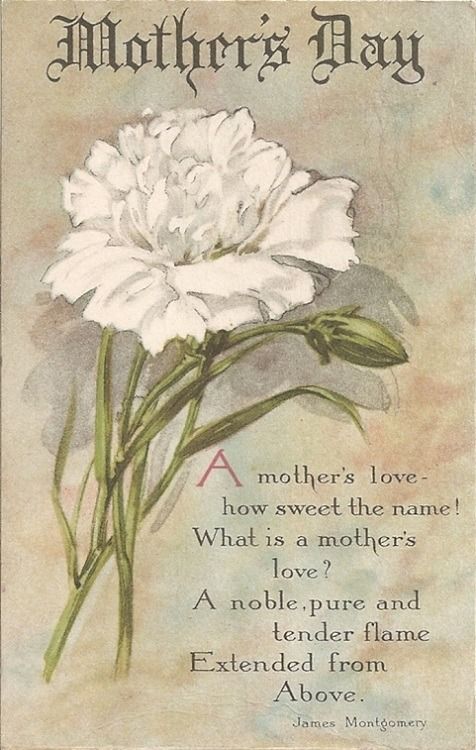Some holiday traditions last, others don’t. Since Mother’s Day is coming up, let’s take a look at its history and its ties to carnations, a tradition that didn’t stand the test of time.

I came across a newspaper article from 1914 about the first Mother’s Day—well, the first Mother’s Day celebrated as a national holiday. A little research provided further details.
Ann Reeves Jarvis was a peace activist who nursed both Confederate and Union wounded during the Civil War. Mrs. Jarvis had created Mother’s Day Work Clubs in the 1850s (later known as Mothers Friendship Clubs) to address public health issues of the times. Having lost 8 of her 12 children when they were under 7 years old, she sought to improve health and sanitation conditions that caused the high mortality rate of youngsters. Her clubs provided medicine to those who couldn’t afford it, nursed the sick and arranged care for tuberculosis victims. After the war, Mrs. Jarvis turned to reuniting families torn apart by war, organizing a “Mothers Friendship Day.”
But the idea of a day about mothers wasn’t new. The ancient Greeks celebrated Rhea, mother of the gods. Romans similarly celebrated Magna Mater. In the 1600s, “Mothering Sunday” was celebrated during Lent. Servants were given a day off to spend with their mothers.
The modern concept of Mother’s Day really begins with Julia Ward Howe, author of the lyrics to the Battle Hymn of the Republic. She promoted a “Mother’s Day for Peace” in 1872. It wasn’t intended to honor mothers but to promote disarmament and organize pacifists. Attempts to establish the holiday continued through the 1880s and 90s, to no avail.

But let’s return to Ann Reeves Jarvis who died in 1905, when her daughter, Anna Jarvis, continued her mother’s work. Believing mothers made more of a difference to their children than any person in the world, she was determined to set aside a day to honor them.
She sent 500 white carnations to her mother’s congregation, St. Andrew’s located in Grafton, West Virginia. The following year, 1908, she held a memorial for her mother there. West Virginia became the first state to declare Mother’s Day a holiday.
Although Congress rejected the initial proposal to make Mother’s Day an official holiday, by 1911, all U.S. states observed the day. Anna’s tireless efforts resulted in a national holiday proclaimed by Woodrow Wilson in 1914. The second Monday in May was set aside to honor mothers despite congress’ joke that if they made Mother’s Day a holiday, they would next have to proclaim a Mother-in-Law’s Day.

Originally, American flags honored mothers who lost a son to war. White carnations were important to the holiday, a tradition I’d never been taught. Why did Jarvis choose the white carnation to honor her mother?
The symbolic language of flowers became especially popular during Victorian times. Flowers were used to deliver secret messages considered improper if spoken aloud. Standing for sweetness and loveliness, innocence and pure love, the white carnation was considered a good luck gift to women. It appears Anna Jarvis made a historic floral choice for Mother’s Day.

Mother’s Day quickly became the commercial success it remains today. Hallmark and other companies marketed greeting cards. Although successful in founding Mother’s Day, Jarvis was disappointed, feeling the emphasis should be on sentiment, not profit. She organized boycotts in the 1920s and was even arrested for disturbing the peace!
Florists and greeting card companies might continue to make sizeable profits, but it’s possible Mother’s Day might not have survived without commercialization. Other holidays originating at the same time such as Children’s Day and Temperance Sunday did not last.
Carnations were popular when I was young. They fell out of favor for years but are making a comeback. Long vase life, amazing color combinations and affordability are returning them to popularity. Why not give a nod to history and use white carnations to honor your mom this Mother’s Day?

